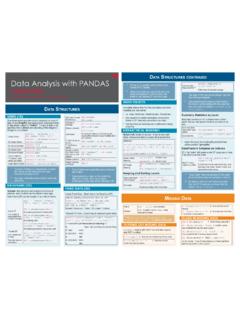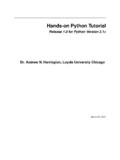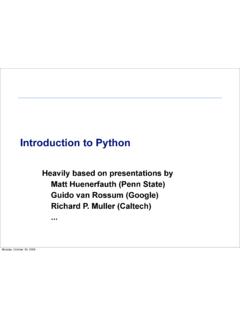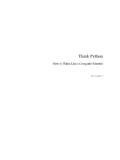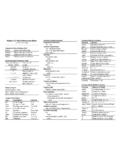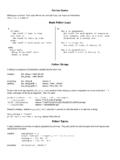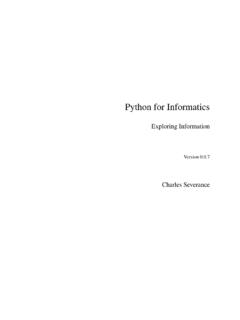Transcription of s Python Cheat Sheet - Data Science Free
1 GeneralPython Cheat Sheetjust the basicsCreated By: arianne Colton and Sean Chen Data structuresNote : 'start' index is included, but 'stop' index is NOT. start/stop can be omitted in which they default to the start/end. Application of 'step' : Take every other element list1[::2]Reverse a string str1[::-1]DICT (HASH MAP)Create Dict dict1 = {'key1' : 'value1' , 2 :[3, 2]}Create Dict from Sequence dict(zip(keyList, valueList))Get/Set/Insert Element dict1['key1']* dict1['key1'] = 'newValue'Get with Default Value ('key1', defaultValue) **Check if Key Exists 'key1' in dict1 Delete Element del dict1['key1']Get Key List () **Get Value List () **Update Values (dict2) # dict1 values are replaced by dict2* 'KeyError' exception if the key does not exist.
2 ** 'get()' by default (aka no 'defaultValue') will return 'None' if the key does not exist.** Returns the lists of keys and values in the same order. However, the order is not any particular order, aka it is most likely not dict key types Keys have to be immutable like scalar types (int, float, string) or tuples (all the objects in the tuple need to be immutable too) The technical term here is 'hashability', check whether an object is hashable with the hash('this is string'), hash([1, 2]) - this would A set is an unordered collection of UNIQUE elements.
3 You can think of them like dicts but keys Set set([3, 6, 3]) or {3, 6, 3}Test Subset (set2)Test Superset (set2)Test sets have same content set1 == set2 Set operations :Union(aka 'or') set1 | set2 Intersection (aka 'and') set1 & set2 Difference set1 - set2 Symmetric Difference (aka 'xor') set1 ^ set2 Create Tuple tup1 = 4, 5, 6 or tup1 = (6,7,8)Create Nested Tuple tup1 = (4,5,6), (7,8)Convert Sequence or Iterator to Tuple tuple([1, 0, 2])
4 Concatenate Tuples tup1 + tup2 Unpack Tuple a, b, c = tup1 Application of TupleSwap variables b, a = a, bLISTOne dimensional, variable length, mutable ( contents can be modified) sequence of Python objects of ANY List list1 = [1, 'a', 3] or list1 = list(tup1)Concatenate Lists* list1 + list2 or (list2) Append to End of ('b')Insert to Specific Position (posIdx, 'b') **Inverse of Insert valueAtIdx = (posIdx)Remove First Value from List ('a') Check Membership 3 in list1 => True **Sort List ()Sort with User-Supplied Function (key = len) # sort by length* List concatenation using '+' is expensive since a new list must be created and objects copied over.
5 Thus, extend() is preferable.** Insert is computationally expensive compared with append.** Checking that a list contains a value is lot slower than dicts and sets as Python makes a linear scan where others (based on hash tables) in constant time. Built-in 'bisect module Implements binary search and insertion into a sorted list ' ' finds the location, where ' ' actually inserts into that location. WARNING : bisect module functions do not check whether the list is sorted, doing so would be computationally expensive.
6 Thus, using them in an unsorted list will succeed without error but may lead to incorrect FOR SEQUENCE TYPES Sequence types include 'str', 'array', 'tuple', 'list', [start:stop]list1[start:stop:step] (If step is used) scalar types* str(), bool(), int() and float() are also explicit type cast NoneType(None) - Python 'null' value (ONLY one instance of None object exists) None is not a reserved keyword but rather a unique instance of 'NoneType' None is common default value for optional function arguments : def func1(a, b, c = None) Common usage of None : if variable is None :6.
7 Datetime - built-in Python 'datetime' module provides 'datetime', 'date', 'time' types. 'datetime' combines information stored in 'date' and 'time'Create datetime from String dt1 = ('20091031', '%Y%m%d')G e t ' d a t e ' o b j e c t ()G e t ' t i m e ' o b j e c t ()Format datetime to String ('%m/%d/%Y %H:%M')Change Field Value dt2 = (minute = 0, second = 30)Get Difference diff = dt1 - dt2 # diff is a ' ' objectNote : Most objects in Python are mutable except for 'strings' and 'tuples'scalar typesNote.
8 All non-Get function call () examples below are in-place (without creating a new object) operations unless noted dimensional, fixed-length, immutable sequence of Python objects of ANY structures Python is case sensitive Python index starts from 0 Python uses whitespace (tabs or spaces) to indent code instead of using e l p H o m e P a g e help()Function Help help( )Module Help help(re)MODULE (AKA LIBRARY) Python module is simply a '.py' fileList Module Contents dir(module1)Load Module import module1 *Call Function from Module ()* import statement creates a new namespace and executes all the statements in the associated.
9 Py file within that namespace. If you want to load the module's content into current namespace, use 'from module1 import * 'Check data type : type(variable)SIX COMMONLY USED DATA TYPES1. int/long* - Large int automatically converts to long2. float* - 64 bits, there is no 'double' type3. bool* - True or False4. str* - ASCII valued in Python and Unicode in Python 3 String can be in single/double/triple quotes String is a sequence of characters, thus can be treated like other sequences Special character can be done via \ or preface with rstr1 = r'this\f?
10 Ff' String formatting can be done in a number of waystemplate = '%.2f %s haha $%d'; str1 = template % ( , 'hola', 2)exception hanDlinG1. Basic Form :try: ..except ValueError as e: print eexcept (TypeError, AnotherError): ..except: ..finally: .. # clean up, close db2. Raise Exception Manuallyraise AssertionError # assertion failedraise SystemExit # request program exitraise RuntimeError('Error message : ..')FunctionsCreated by Arianne Colton and Sean Chen on content from ' Python for Data Analysis' by Wes McKinneyUpdated: May 3, 2016control anD Flow1.

